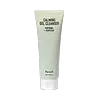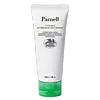What's inside
What's inside
 Key Ingredients
Key Ingredients

 Benefits
Benefits

 Concerns
Concerns

 Ingredients Side-by-side
Ingredients Side-by-side

Water
Skin ConditioningSodium C14-16 Olefin Sulfonate
CleansingLauryl Betaine
CleansingAcrylates Copolymer
Glycerin
Humectant1,2-Hexanediol
Skin ConditioningSodium Chloride
MaskingCentella Asiatica Leaf Water
Skin ConditioningHexadecene
SolventTetradecene
EmollientEthylhexylglycerin
Skin ConditioningCaprylyl Glycol
EmollientHouttuynia Cordata Powder
Skin ConditioningArginine
MaskingDisodium EDTA
Panthenol
Skin ConditioningButylene Glycol
HumectantHouttuynia Cordata Extract
Skin ConditioningLactobacillus Ferment
Skin ConditioningCitric Acid
BufferingHydrogenated Lecithin
EmulsifyingCholesterol
EmollientCaprylic/Capric Triglyceride
MaskingAscorbic Acid
AntioxidantBakuchiol
AntimicrobialHyaluronic Acid
HumectantNiacinamide
SmoothingCeramide NP
Skin ConditioningWater, Sodium C14-16 Olefin Sulfonate, Lauryl Betaine, Acrylates Copolymer, Glycerin, 1,2-Hexanediol, Sodium Chloride, Centella Asiatica Leaf Water, Hexadecene, Tetradecene, Ethylhexylglycerin, Caprylyl Glycol, Houttuynia Cordata Powder, Arginine, Disodium EDTA, Panthenol, Butylene Glycol, Houttuynia Cordata Extract, Lactobacillus Ferment, Citric Acid, Hydrogenated Lecithin, Cholesterol, Caprylic/Capric Triglyceride, Ascorbic Acid, Bakuchiol, Hyaluronic Acid, Niacinamide, Ceramide NP
Centella Asiatica Extract
CleansingWater
Skin ConditioningPotassium Cocoyl Glycinate
Lauryl Hydroxysultaine
CleansingGlycerin
HumectantAcrylates Copolymer
Propanediol
SolventSodium Chloride
Masking1,2-Hexanediol
Skin ConditioningTromethamine
BufferingPotassium Benzoate
PreservativeSalicylic Acid
MaskingLactobacillus Ferment
Skin ConditioningStyrene/Acrylates Copolymer
Melaleuca Alternifolia Leaf Oil
AntioxidantDisodium EDTA
Rosmarinus Officinalis Leaf Oil
MaskingMelia Azadirachta Leaf Extract
Skin ConditioningCoco-Glucoside
CleansingTheobroma Cacao Seed Extract
AntioxidantArtemisia Vulgaris Oil
PerfumingMelia Azadirachta Flower Extract
Skin ConditioningPentylene Glycol
Skin ConditioningDextrin
AbsorbentLeptospermum Scoparium Leaf Extract
Skin ConditioningButylene Glycol
HumectantMadecassoside
AntioxidantLimnanthes Alba Seed Oil
Skin ConditioningBenzoic Acid
MaskingCitric Acid
BufferingCeramide NP
Skin ConditioningPhytosphingosine
Skin ConditioningHydrogenated Lecithin
EmulsifyingHoney Extract
HumectantCentella Asiatica Extract, Water, Potassium Cocoyl Glycinate, Lauryl Hydroxysultaine, Glycerin, Acrylates Copolymer, Propanediol, Sodium Chloride, 1,2-Hexanediol, Tromethamine, Potassium Benzoate, Salicylic Acid, Lactobacillus Ferment, Styrene/Acrylates Copolymer, Melaleuca Alternifolia Leaf Oil, Disodium EDTA, Rosmarinus Officinalis Leaf Oil, Melia Azadirachta Leaf Extract, Coco-Glucoside, Theobroma Cacao Seed Extract, Artemisia Vulgaris Oil, Melia Azadirachta Flower Extract, Pentylene Glycol, Dextrin, Leptospermum Scoparium Leaf Extract, Butylene Glycol, Madecassoside, Limnanthes Alba Seed Oil, Benzoic Acid, Citric Acid, Ceramide NP, Phytosphingosine, Hydrogenated Lecithin, Honey Extract
Ingredients Explained
These ingredients are found in both products.
Ingredients higher up in an ingredient list are typically present in a larger amount.
1,2-Hexanediol is a synthetic liquid and another multi-functional powerhouse.
It is a:
- Humectant, drawing moisture into the skin
- Emollient, helping to soften skin
- Solvent, dispersing and stabilizing formulas
- Preservative booster, enhancing the antimicrobial activity of other preservatives
Acrylates Copolymer is used as a film-forming agent and texture enhancer.
After applied, Acrylates Copolymer forms a thin film cover that helps skin feel more soft. It can help sunscreens become more water-resistant.
It is also used to make a product more thick.
Learn more about Acrylates CopolymerButylene Glycol (or BG) is used within cosmetic products for a few different reasons:
Overall, Butylene Glycol is a safe and well-rounded ingredient that works well with other ingredients.
Though this ingredient works well with most skin types, some people with sensitive skin may experience a reaction such as allergic rashes, closed comedones, or itchiness.
Learn more about Butylene GlycolCeramide NP is a type of ceramide and formally known as ceramide 3.
Ceramides are intercellular lipids naturally found in our skin that bonds dead skin cells together to create a barrier. They are known for their ability to hold water and thus are a great ingredient for dry skin.
Ceramides are an important building block for our skin barrier. A stronger barrier helps the skin look more firm and hydrated. By bolstering the skin ceramides act as a barrier against irritating ingredients. This can help with inflammation as well.
If you would like to eat ceramides, sweet potatoes contain a small amount.
Read more about other common types of ceramides here:
Ceramide AP
Ceramide EOP
Citric Acid is an alpha hydroxy acid (AHA) naturally found in citrus fruits like oranges, lemons, and limes.
Like other AHAs, citric acid can exfoliate skin by breaking down the bonds that hold dead skin cells together. This helps reveal smoother and brighter skin underneath.
However, this exfoliating effect only happens at high concentrations (20%) which can be hard to find in cosmetic products.
Due to this, citric acid is usually included in small amounts as a pH adjuster. This helps keep products slightly more acidic and compatible with skin's natural pH.
In skincare formulas, citric acid can:
While it can provide some skin benefits, research shows lactic acid and glycolic acid are generally more effective and less irritating exfoliants.
Most citric acid used in skincare today is made by fermenting sugars (usually from molasses). This synthetic version is identical to the natural citrus form but easier to stabilize and use in formulations.
Read more about some other popular AHA's here:
Learn more about Citric AcidDisodium EDTA plays a role in making products more stable by aiding other preservatives.
It is a chelating agent, meaning it neutralizes metal ions that may be found in a product.
Disodium EDTA is a salt of edetic acid and is found to be safe in cosmetic ingredients.
Learn more about Disodium EDTAGlycerin is already naturally found in your skin. It helps moisturize and protect your skin.
A study from 2016 found glycerin to be more effective as a humectant than AHAs and hyaluronic acid.
As a humectant, it helps the skin stay hydrated by pulling moisture to your skin. The low molecular weight of glycerin allows it to pull moisture into the deeper layers of your skin.
Hydrated skin improves your skin barrier; Your skin barrier helps protect against irritants and bacteria.
Glycerin has also been found to have antimicrobial and antiviral properties. Due to these properties, glycerin is often used in wound and burn treatments.
In cosmetics, glycerin is usually derived from plants such as soybean or palm. However, it can also be sourced from animals, such as tallow or animal fat.
This ingredient is organic, colorless, odorless, and non-toxic.
Glycerin is the name for this ingredient in American English. British English uses Glycerol/Glycerine.
Learn more about GlycerinHydrogenated Lecithin is created from the hydrogenation of lecithin (a group of phospholipids). Hydrogenation is a chemical reaction between hydrogen and another element.
This ingredient is an emollient and emulsifier. As an emollient, it helps soften skin by trapping moisture within. As an emulsifier, it prevents oil and water ingredients from separating.
Lactobacillus Ferment is created by fermenting the Lactobacillus bacteria. It helps keep our skin's natural barrier and microbiome healthy.
Studies show lactobacillus ferment to be effective at repairing the skin barrier. Having a healthy skin barrier helps keep your skin healthy and hydrated. It also protects against bad bacteria.
As a probiotic/prebiotic/postbiotic, Lactobacillus ferment can help regular our natural biome. In fact, one study found a lack of diversity in our natural skin biome can trigger acne.
Learn more about Lactobacillus FermentChances are, you eat sodium chloride every day. Sodium Chloride is also known as table salt.
This ingredient has many purposes in skincare: thickener, emulsifier, and exfoliator.
You'll most likely find this ingredient in cleansers where it is used to create a gel-like texture. As an emulsifier, it also prevents ingredients from separating.
There is much debate on whether this ingredient is comedogenic. The short answer - comedogenic ratings don't tell the whole story. Learn more about comegodenic ratings here.
The concensus about this ingredient causing acne seems to be divided. Research is needed to understand if this ingredient does cause acne.
Scrubs may use salt as the primary exfoliating ingredient.
Learn more about Sodium ChlorideWater. It's the most common cosmetic ingredient of all. You'll usually see it at the top of ingredient lists, meaning that it makes up the largest part of the product.
So why is it so popular? Water most often acts as a solvent - this means that it helps dissolve other ingredients into the formulation.
You'll also recognize water as that liquid we all need to stay alive. If you see this, drink a glass of water. Stay hydrated!
Learn more about Water